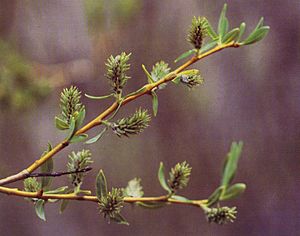Lemmon's willow facts for kids
Quick facts for kids Lemmon's willow |
|
|---|---|
 |
|
| Scientific classification | |
| Genus: |
Salix
|
| Species: |
lemmonii
|
Salix lemmonii, also known as Lemmon's willow, is a type of willow tree or shrub. It was named after J.G. Lemmon, a botanist. This plant grows naturally in western North America. You can find it from British Columbia in Canada all the way down to California and over to Colorado in the United States.
Lemmon's willow loves wet places. It often grows near streams and in damp meadows within mountain forests.
What is Lemmon's Willow Like?
Lemmon's willow is usually a shrub, which is a woody plant smaller than a tree. It can grow between 1 and 4 meters (about 3 to 13 feet) tall. Sometimes, many of these plants grow close together, forming thick groups called "thickets."
Its stems grow in a bunch and spread out into many thin, angled branches. The leaves can be up to 11 centimeters (about 4 inches) long. They are shaped like a spear or an oval with pointed ends. The edges of the leaves can be smooth or have small teeth. They are usually hairless and feel a bit waxy, or sometimes they have a few hairs.
Flowers and Seeds
The flowers of Lemmon's willow grow in a thick cluster called a catkin. These catkins are a few centimeters long. The female catkins get longer, up to 6 or 7 centimeters, as the fruits start to grow.
Sometimes, Lemmon's willow can mix with another type of willow called Salix geyeriana. This means they can create a new plant that has features from both parents. They are very closely related.
Why is Lemmon's Willow Important?
Lemmon's willow is very helpful in nature. It is often used in projects to bring natural areas back to life. This is especially true in places where it grows naturally.
This willow is great for stopping erosion. Erosion happens when soil is washed away by water or wind. Lemmon's willow helps hold the soil in place along riverbanks and other wet areas. This keeps the land healthy and stable.
See also
 In Spanish: Salix lemmonii para niños
In Spanish: Salix lemmonii para niños

